 For me, there is just one way to eat a croissant: Lukewarm with some nutella. But when I buy croissants in the bakery, they are cold. Of course I can place them shortly in the oven, but that is not the same. But there is a solution: Bake croissants by myself.
For me, there is just one way to eat a croissant: Lukewarm with some nutella. But when I buy croissants in the bakery, they are cold. Of course I can place them shortly in the oven, but that is not the same. But there is a solution: Bake croissants by myself.
The last time I bake croissants I was not satisfied, because the croissants were not so fluffy like they should be. So it was time to try another recipe.
I decided to try a recipe that use pâte fermentée. It needs a lot of time, but most of the time is fermenting time in the fridge, so it does not matter to me.
To get fresh baked croissants on sunday morning, I started thursday night the pâte fermentée, friday night I prepared the dough, sunday i did the roll-in of the butter and formed the croissants. On Sunday morning I just take out the baking tray and placed the croissants in the oven. After all, it was not much work on each day, it just needed a lot of time!
But the outcome was perfekt: fluffy, layered, buttery taste … thats how croissants have to be!
Croissants mit Pâte fermentée
yields 12 Croissants
Pâte fermentée:
- 125 g flour (Type 550)
- 85g water
- 1g yeast
- 2 g salt
Dough:
- whole Pâte fermentée
- 500g flour (Type 550)
- 145g milk
- 165g water
- 25g butter
- 15g yeast
- 10g salt
- 80g sugar
Roll-in:
- 225g butter
Mix all ingredients for the pâte fermentée and ferment it for 1 hour at room temperature. Then put the dough into the fridge for at least 12 hours.
For the dough mix alle incredients aside the sugar and kneat them with the kitchen machine for 6 min at low speed.
Now ad the sugar in small portions and knead one minute before adding the next portion. Adding the sugar later helps to build up the gluten!
Put the dough into the fridge untill next morning.
Take out the cold butter and place it between two plastic foils. Then hit the butter with the rolling pin untill a plate has formed and the butter is softend.
Roll the dough to a square with an edge length of 30 cm x 45 cm and put the butterplate in the middle. Fold the doug over the butter and roll again. Fold the dough in thirds (like a letter) and cool in the fridge for at least 45 min (better 1 hour).
Repeat the rolling, folding and cooling Steps for another two times.
After the last resting periode, roll the dough to an 40 cm x 45 cm rectangle
Cut the dough into 2 stripes of 20 cm x 45 cm and each strip into 6 triangle. Roll them up from the small side.
Place them on a baking tray, cover it with clingfilm and place it in the fridge untill next morning.
Heat the oven to 225°C and place the tray directly out of the fridge in the oven. Bake for 15 min.

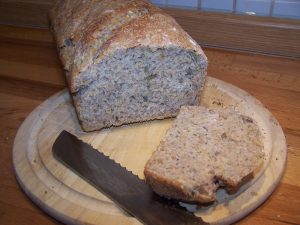 The theme for Bread Baking Day No. 20 is “Multigrain Breads”. That is a perfect theme for me because I love the gain of flavor that the diffrent typs of grain give to the bread.
The theme for Bread Baking Day No. 20 is “Multigrain Breads”. That is a perfect theme for me because I love the gain of flavor that the diffrent typs of grain give to the bread.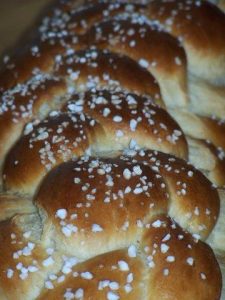 I am fear, that I am infected with the “baking braided Bread Fever”. After baking Eggbread two weeks ago, I had to try the next braided bread from “Advanced Bread and Pastry”. The Challah is a traditional jewish holiday bread, and my recipe is, as I learned now, not correct, because ist contains dairy products. But nevertheless it is a delicious bread.
I am fear, that I am infected with the “baking braided Bread Fever”. After baking Eggbread two weeks ago, I had to try the next braided bread from “Advanced Bread and Pastry”. The Challah is a traditional jewish holiday bread, and my recipe is, as I learned now, not correct, because ist contains dairy products. But nevertheless it is a delicious bread.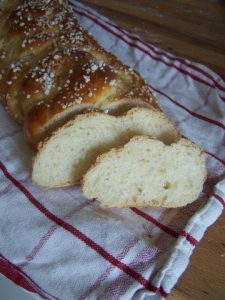
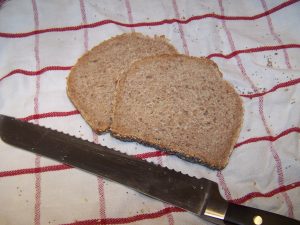
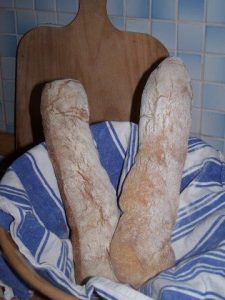
 I promise to bake some bread for an Easter-Dinner with my parents. It’s been a long time since I baked Baguette, and there are so many nice recipes in “Advanced Bread and Pastry” that I had not to think about what kind of bread I want to bake.
I promise to bake some bread for an Easter-Dinner with my parents. It’s been a long time since I baked Baguette, and there are so many nice recipes in “Advanced Bread and Pastry” that I had not to think about what kind of bread I want to bake. We do house-sitting at my parents place during the Easter holidays. The weather was fine, so we spend a lot of time in the garden. But free days are not perfect without baking for me. I brought sourdough, seeds and grain from home, my mum has a kitchen machine and a lot of bread pans.
We do house-sitting at my parents place during the Easter holidays. The weather was fine, so we spend a lot of time in the garden. But free days are not perfect without baking for me. I brought sourdough, seeds and grain from home, my mum has a kitchen machine and a lot of bread pans.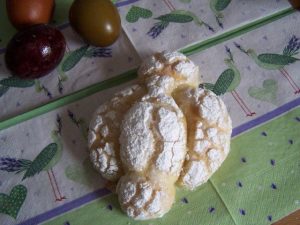 I learned two years ago, that there exist a Easterbread called Colomba, when my italian collegue brought one from Italy after easter holidays with her parents. With this incredibly soft texture of the crumb unter a sugar crust it was one of the delicouse things I ever tested. To sad that my collegue did not bake at all, so she had no recipe for me.
I learned two years ago, that there exist a Easterbread called Colomba, when my italian collegue brought one from Italy after easter holidays with her parents. With this incredibly soft texture of the crumb unter a sugar crust it was one of the delicouse things I ever tested. To sad that my collegue did not bake at all, so she had no recipe for me.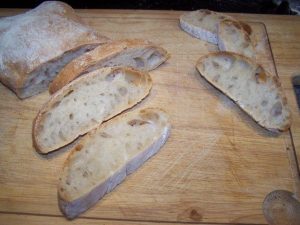 Somewhere in germany, in the middle of the night: a dark figure sneaks out of the sleeping room and tiptoes into the kitchen. The alarm clock shows three o’clock. In the kitchen, the figure opens quietly cupboards and take out bowls, yeast and flour and prepares a poolish.
Somewhere in germany, in the middle of the night: a dark figure sneaks out of the sleeping room and tiptoes into the kitchen. The alarm clock shows three o’clock. In the kitchen, the figure opens quietly cupboards and take out bowls, yeast and flour and prepares a poolish.